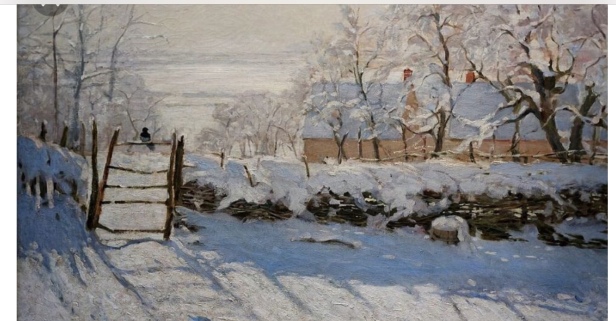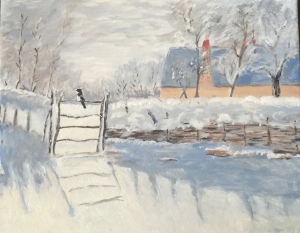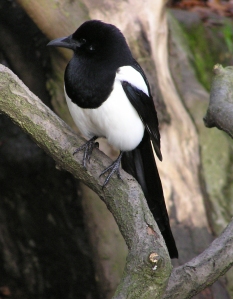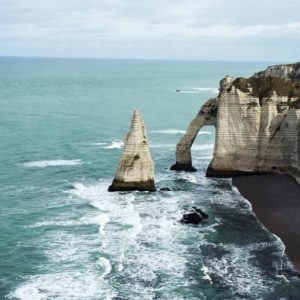
“How does it happen that birds sing, that snow melts, that the rose unfolds, that the dawn whitens behind the stark shapes of trees on the quivering summit of the hill?”
-Victor Hugo
My first glimpse of Monet’s Magpie at the Musée D’Orsay was in 2005. Snow! A wonderland of quiet, still, tranquility. My eye was drawn to the light of the sun which shines upon this freshly fallen snow, creating blue shadows. And then, voila, there he sat: this little black bird with a white breast, perched upon a roughly hewn fence post, greeting the day. All of this lovely milieu as a backdrop.
I have been wanting to copy Monet’s painting for quiet some time. Today, I finally had my chance. Fortunately, I have a wonderful art teacher, Marie, who excels at landscapes, especially winter landscapes, so this recreation would now be possible!
As with most winter landscapes, there will be snow! Lots of snow. But in the art world, snow is never white! Monet introduced us to, and perfected, colored snow. This colored snow was actually very hard to imitate as I spent many attempts mixing white with cobalt blue and violet, cadmium yellow, and burnt sienna. These shadows represent the actual changing conditions of light and shadow as seen in nature. Equally challenging was to depict the sunlight coming through the trees onto the snow. The sunlight has specks of cadmium yellows, vermilion and cobalt blues. My art teacher, Marie, is an expert in this area and instructed me every bit of the way. “Light against dark, dark against light; the darkest part is at the bottom to give the object a foundation in which to sit”.

The most important part of this painting is, of course, the magpie. Before we began our adventure of copying Monet’s painting, Marie and I were discussing this illusive black and white-feathered creature as we have never seen one. They are generally found in Europe, Asia and north-western United States. These birds are very hearty and can be found throughout winter. As Monet tried to render his impressions in the fleeting effects, this magpie that he painted only stayed on this fencepost for a few seconds; or perhaps he came o’ the mornings, searching for food. Either way, Monet had to paint this magpie from memory as photography was just being introduced.

The magpie was the last detail that we painted. My first attempt was horrendous. The magical thing about acrylic painting is that it is forgiving. So with a few strokes of white paint, this unproportionate black blob was no longer in my painting! My second attempt was much better. As you can see in the picture above, the magpie has a white chest, framed by jet-black feathers.

One reason this painting is so special to me is because Monet painted it near his home in Étretat, Normandie. Last year, my husband took me to visit Étretat for our 35th anniversary as this had been on my bucket list for many years. This picturesque French town with incredible cliff formations was an inspiration for Monet and many other Impressionists during the 1800’s. It is the most breath-taking place I have ever visited. These cliffs were the inspiration for my first painting one year ago.

Today marks the anniversary of Monet’s death and my friend Marie and I finished our Impressions of his iconic Magpie. In his last year, Monet remarked,
“My only merit lies in having painted directly in front of nature, seeking to render my impressions of the most fleeting effect“.
I am thankful Monet gave us a glimpse into his wintry home in Etretat and that I have a talented friend who helped me capture this wonderland onto a canvas.
Copyright 2018 by Robyn Lowrie. May be quoted in part or full only with attribution to Robyn Lowrie (www.frenchquest.com)

very neat! I miss magpies in the US
Your painting turned out very well! We saw the magpie in Alberta Canada as well. They are much like blue jays here. Often a nuisance for those who have them around.
Thank you, it was so fun to paint! If I can’t see the real thing, at least I can imagine them through this medium!
I also fall in love with Monet, especially this painting – Magpie. It’s great to read your words cause you speak my thoughts 🙂
I love to hear this! Monet painted the Magpie in Etretat, along with the Cliffs series. I’m visiting this enchanting coast next month. So excited!
great paintings